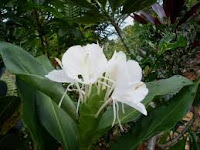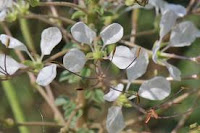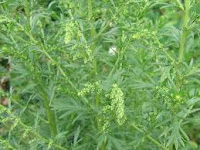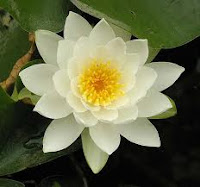White ginger is not a true ginger, although it is in the same family, Zingiberaceae, as the ginger we use for cooking. As it is in this family it is also related to cardamoms, fingerroot or Chinese ginger, turmeric and white turmeric or zedoary, and galangal (Alpinia galanga), among others. This is native to the Himalayan region, but they are now spread throughout the Pacific islands and other tropical and sub-tropical parts of the world.
The flower and young buds are edible and can be used as a flavouring but their potent smell in the evening shows that their value is in the essential oil obtained from these blooms. The flowers are woven into leis in Hawaii and used in garlands elsewhere in the world too. They are the national flowers of Cuba , although they are not indigenous to the island. They were introduced, but have taken hold in some areas of the island and grow wild now. They were introduced during the Spanish colonial times. There they are called “Mariposa blanca” or white butterfly flower, which describes the blooms admirably well.
The essential oil of the flowers is used for high quality perfumes and in soaps and other toiletries. The root contains a volatile oil which is used in medicine. The root is not used in cooking, but has been eaten in times of famine.
 The seeds of this plant are aromatic and used to get rid of flatulence and to help the stomach’s actions. The root is used to get rid of worms, as a stimulant and tonic and for the pains of rheumatism. The ground rhizome is used for fevers.
The seeds of this plant are aromatic and used to get rid of flatulence and to help the stomach’s actions. The root is used to get rid of worms, as a stimulant and tonic and for the pains of rheumatism. The ground rhizome is used for fevers. The plants stems contain cellulose and so are useful in the paper-making process. In fact all parts of this plant have their uses for us.
It was first taken to Brazil by African slaves who used the leaves to sleep on. Now it is considered an invasive weed in that country. It is also invasive in Hawaii and a noxious weed in South Africa and Queensland , Australia . In some countries it is a threat to banana and cocoa plantations.
It is used in the Ayurvedic medicine system of the Indian subcontinent as a stimulant, tonic and to help treat rheumatism. A decoction of the rhizome is used as a gargle for sore throats and tonsillitis, and chewed for the same purposes. The roots and leaves are also used for nasal polyps, and fevers.
The stem can be chewed, and the resulting mash is plastered onto cuts and swellings. In Chinese medicine the plant is used for headaches, inflammation and rheumatism. A boiled poultice of the leaves is placed on sore or stiff joints too in some countries.
 In a part of India the rhizome is used to treat diabetes and research is being carried out to see if this traditional use can be supported by scientific evidence: The Journal of Ethnopharmacology 1995 Vol. 47 (5) pp149-58, “Medical ethnobotany of Siddis of Uttara Kannada district, Karnataka, India”; Bhandary M. J. et al.
In a part of India the rhizome is used to treat diabetes and research is being carried out to see if this traditional use can be supported by scientific evidence: The Journal of Ethnopharmacology 1995 Vol. 47 (5) pp149-58, “Medical ethnobotany of Siddis of Uttara Kannada district, Karnataka, India”; Bhandary M. J. et al. One study has discovered that the essential oil from the fresh and dried rhizomes has antifungal and antimicrobial activities, with that of fresh oil being superior in its actions. “Antimicrobial activity and chemical composition of essential oil from Hedychium coronarium” by Beena Joy et al. in Phytotherapy Research, Vol. 21 (5), pp. 439 – 443.
It also exhibits analgesic and anti-inflammatory properties and actions; “Anti-inflammatory and analgesic effects of Hedychium coronarium Koen. Antioxidant and Antimicrobial Activity of Zingiberaceae Plants in Taiwan ” in Plant Foods for Human Nutrition.
Other research studies have found that the plants have antibacterial and cytotoxic activities, “Antibacterial and Cytotoxic Activities of Hedychium coronarium J. Koenig “ by M Abdul Aziz et al. Research Journal of Agriculture and Biological Sciences, 5(6): 969-972, 2009. The cytotoxic actions were also borne out in “Two new cytotoxic labdane diterpenes from the rhizomes of Hedychium coronarium.” In Bioorganic and Medicinal Chemistry Letters, ISSN: 1464-3405, pp. 7544-8.
It also has potent antioxidant properties, “Antioxidant and tyrosinase inhibition properties of leaves and rhizomes of ginger species” E W C Chan et al. in Food Chemistry Vol.109 (2008) 477–483. Its leaves possess, according to this study, the highest phenolic content and ascorbic acid (vitamin C) in comparison with the leaves of 26 other species of ginger.
The essential oil from the flowers has also been found to have anti-inflammatory actions; ”Anti-inflammation activity and chemical composition of flower essential oil from Hedychium coronarium” by Y Lu, C X Zhong et al in African Journal of Biotechnology Vol. 8 (20), pp. 5373-5377, 19 October, 2009.
Clearly more research need to be done if we are to get the maximum health benefits from what is in some countries an invasive or noxious weed.























































